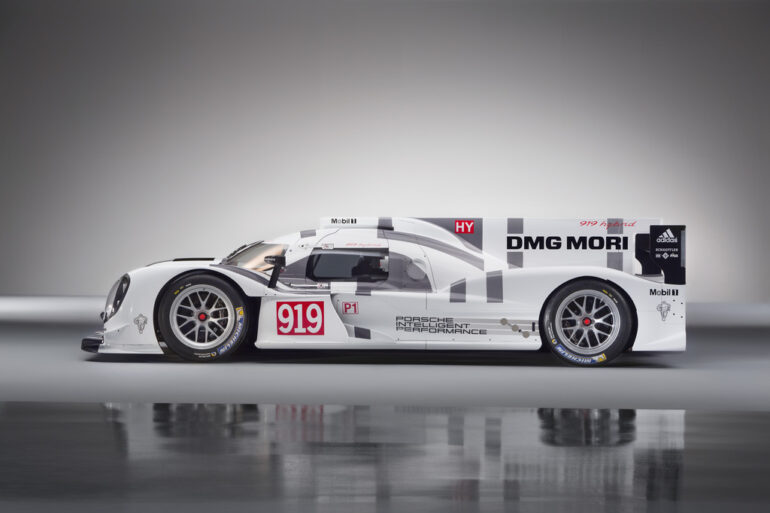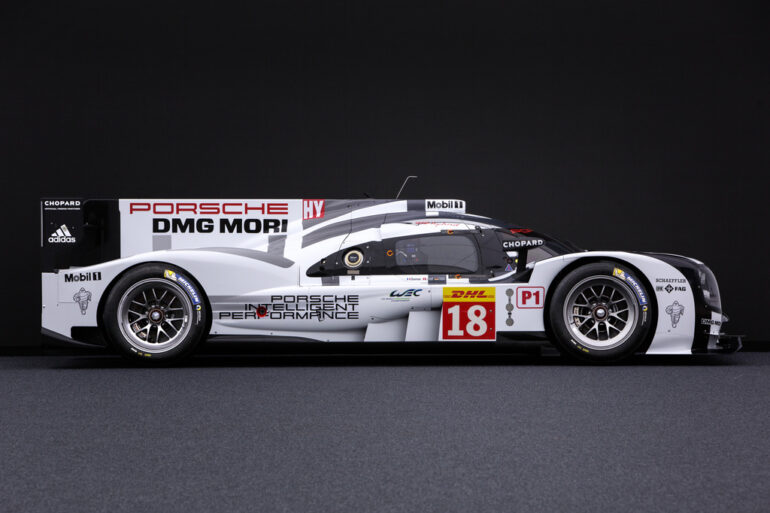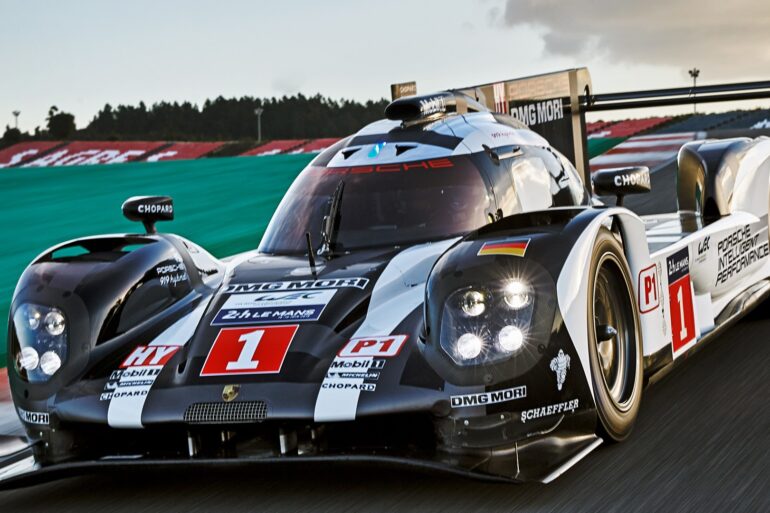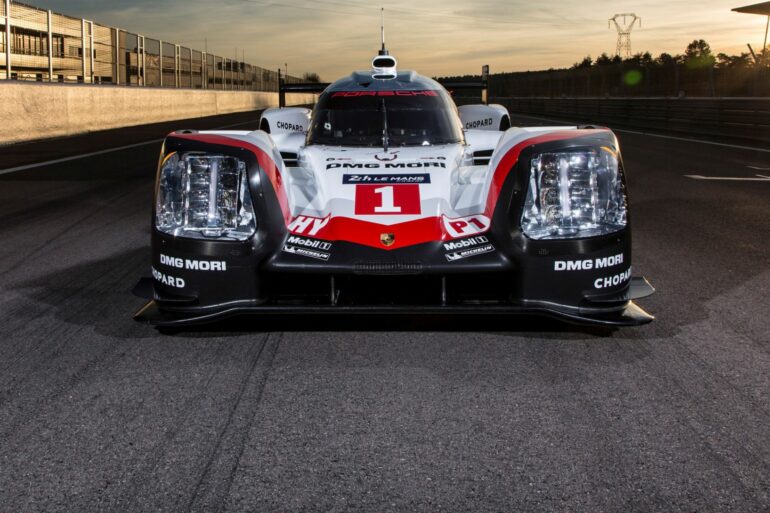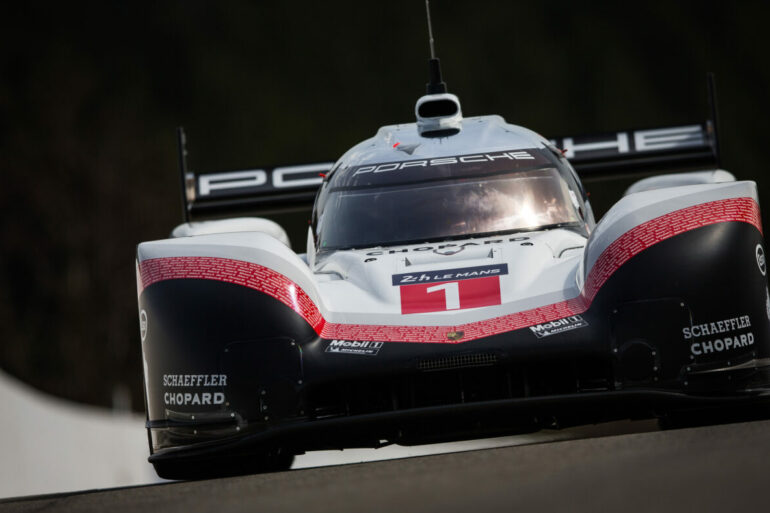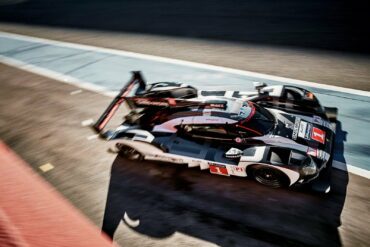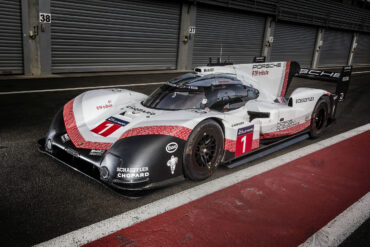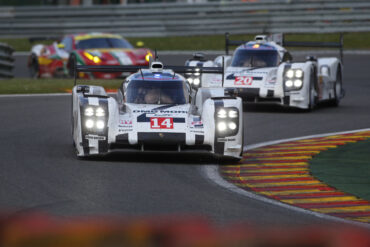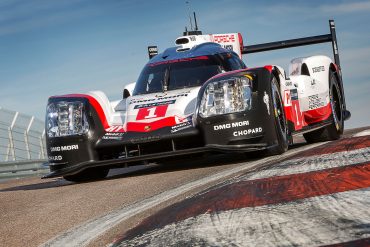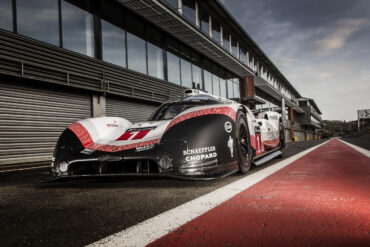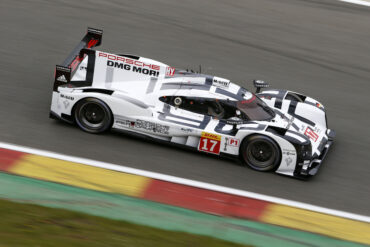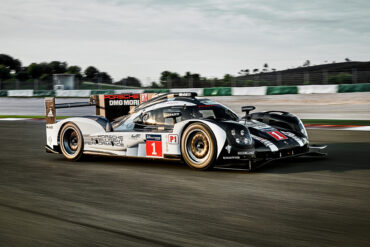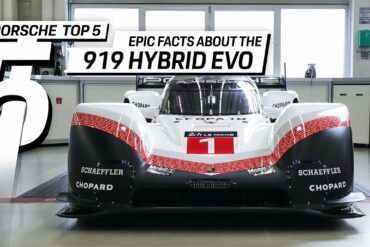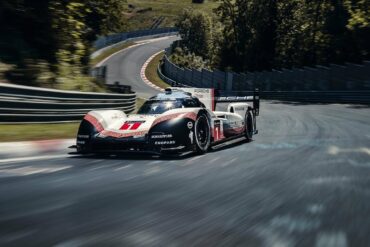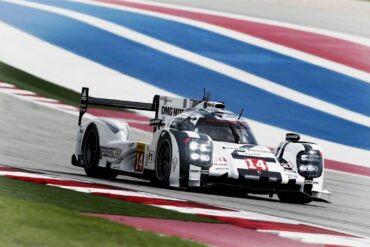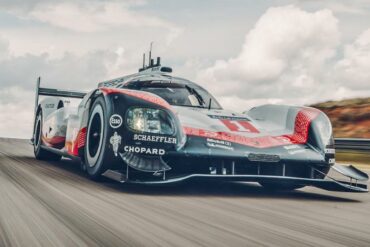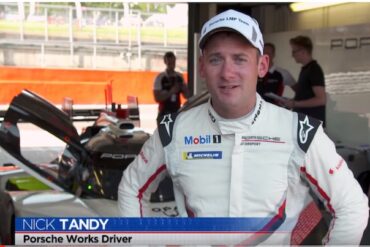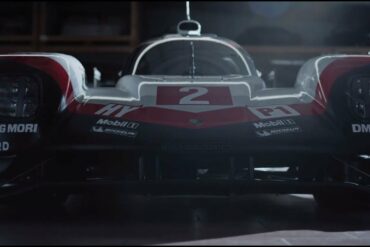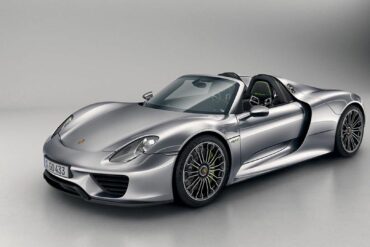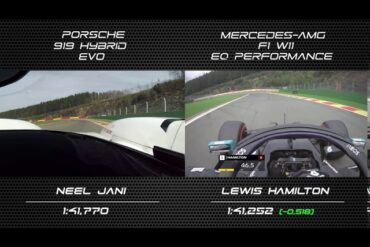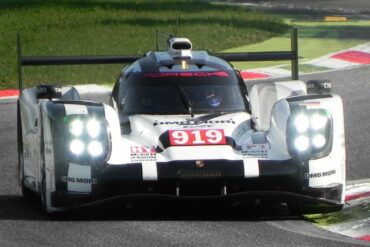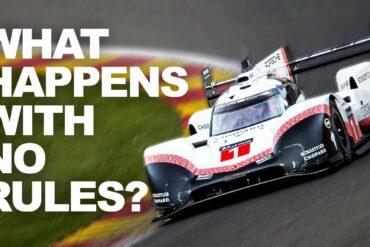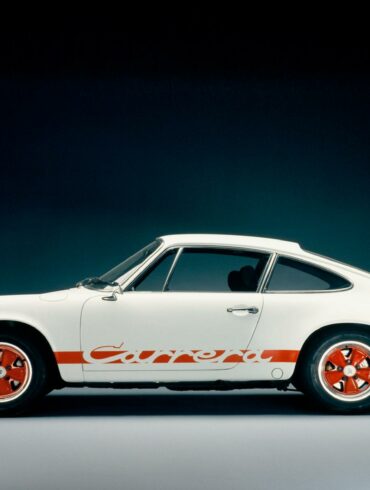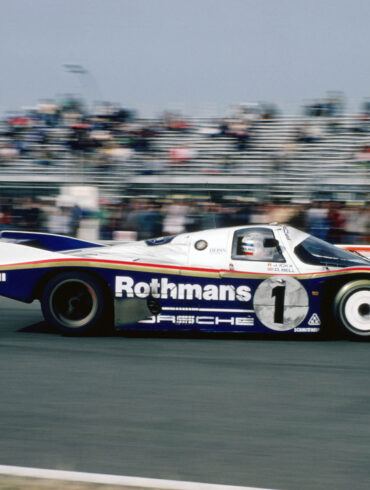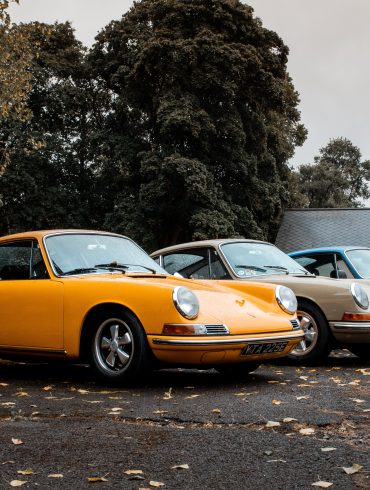The Porsche LMP1-H (Le Mans Prototype Class 1, Hybrid) race car featured a hybrid system that consisted of a turbocharged 2.0V4 petrol engine at the rear axle and an electric motor at the front axle. The electric motor/generator unit (MGU) collected the energy from the front axle under braking and the AER exhaust energy recovery system operated on the exhaust gas - a separate turbocharger ran an alternator.
Porsche 919
The Ultimate Model Guide
The Porsche 919 Hybrid is a Le Mans Prototype 1 (LMP1) racing car built and used by Porsche in the 2014, 2015, 2016 and 2017 seasons of the FIA World Endurance Championship. It has a two-litre (120 cu in) 90-degree V4 mid-mounted mono-turbocharged petrol engine that produces 500 hp (370 kW) and acts as a chassis load-bearing member - and two separate energy-recovery hybrid systems to recover thermal energy from exhaust gases and convert kinetic energy into electrical energy under braking for storage into lithium-ion battery packs. In accordance with the 2014 regulations, the vehicle was placed in the 6 MJ (1.7 kWh) class. The turbocharged, 2.0-litre V4 engine is small in stature but big on power. In WEC-spec it pumped out 500bhp - add in the power from the hybrid system and the 919 delivered well over 900bhp in race spec, with the engine powering the rear wheels and electric motors deploying energy to the front wheels for some serious four-wheel drive traction. Porsche was also the only LMP1 manufacturer to recover energy from a small turbine in the exhaust system (separate to the turbo). This way, the car was also able to charge its lithium-ion battery under acceleration as well as braking - just like in an F1 car. The Porsche 919 Hybrid was competitive from day one and went on to help Porsche win the World Championship in 2015, 2016 and 2017.
Porsche 919 Basics
Manufacturer: Porsche AG / Production Years: 2014 - 2018 / Chassis: Composite of carbon fibre with honeycomb aluminium core / Suspension: Independent multi-link pushrod configuration with adjustable shock absorbers / 2-door coupe / Layout: Rear mid-engine, rear-wheel-drive layout / Engines: Porsche 2.0 L (122 cu in) direct-injected turbocharged V4 engine with lithium-ion battery for energy recovery in mid-mounted longitudinal configuration with 4WD system / Transmission: Porsche 7-speed electro-hydraulic actuated sequential gearbox with rear-lock differential / Predecessor: Porsche RS Spyder
Porsche 919 Variant Guides
The initial racing season for the 919 Hybrid was 2014 but it got upgrades every year. Porsche redesigned the 919 Hybrid for the 2015 season, getting a new chassis with an identical layout, and it was manufactured as one to save weight in the rear crash structure, suspension and aerodynamics from 2,000 lbs to 1,920 lbs. There were a number of other changes around the nose cone and going from centralized exhaust to twin-exhausts. The carbon fibre sandwich chassis was retained for 2016, but many of the car's components were improved because of detailed performance enhancements and weight reduction. Because of a new World Endurance Championship regulation that restricted the amount of available electrical energy and fuel by 8%, Porsche's engineers redesigned the engine to be lighter and produce around 480 to 495 hp (358 to 369 kW). Within the kinetic energy recovery system, the electric motor on the front axle, the power electronics and a new generation of lithium-ion battery cells in the in-house designed car battery were optimised to produce more horsepower. The power delivered by the front axle was more than 400 hp (300 kW) with a cumulative total of 900 hp (670 kW) from both the front and rear to an 800-volt battery. According to Porsche, it retained the monocoque from 2016, but 60 to 70% of the 2017 car was new, with the largest alterations being to its aerodynamic demands. This included a major redesign of the front of the 919 Hybrid with wider arches for the front wheels to make it less aerodynamically sensitive from small bits of discarded rubber from the track surface. The engine was modified to be lighter and more compact, and Porsche stated that it was its most-efficient ever. The final iteration of the 919 Hybrid was the bonkers, F1 car-beating, Nordschleife-conquering Evo version. Mechanically, it was identical to the LMP1-spec car, with the only changes being the removal of the WEC-imposed restrictions. Unlimited fuel flow and new engine management software boosted engine power to 720bhp, while the battery was allowed to harvest and deploy more energy than in race conditions. The result? 1160bhp. It was quite the sendoff.
Porsche 919 Specifications & Performance
Below we have outlined a basic overview of some key specifications for the Porsche 919 variants over its racing life. Note that several horsepower numbers are marked with an * because no official data was made available. Porsche gave users a guide, but not actuals. In these cases the numbers are estimations made by the Stuttcars.com team.
Porsche 919 Race Results
Porsche supplied two cars, driven by six drivers, for the 2014 season. Romain Dumas, Neel Jani and Marc Lieb won three pole positions and the season-ending 6 Hours of São Paulo as Timo Bernhard, Brendon Hartley and Mark Webber helped the team to finish third in the World Manufacturers' Championship. Bernhard, Hartley, and Webber won four out of eight races to claim the 2015 World Endurance Drivers' Championship and the World Championship. Earl Bamber, Nico Hülkenberg and Nick Tandy won the 6 Hours of Spa-Francorchamps and 24 Hours of Le Mans, driving a third 919 Hybrid. In 2016 Dumas, Jani, and Lieb won the 6 Hours of Silverstone and the 24 Hours of Le Mans with the car after further development. Consistent performances from the trio won them the 2016 World Endurance Drivers' Championship and the team's second. Although Bernhard, Hartley, and Webber had reliability issues in the season's first three races, the trio won four of the six remaining rounds to help Porsche win its second consecutive World Manufacturers' Championship. The next year, 2017, Tandy and former Audi LMP1 driver André Lotterer joined Jani in place of Dumas and Lieb, and Bamber teamed up with Bernhard and Hartley, replacing the retired Webber. Porsche finished on the podium in the first two rounds. Bamber, Bernhard, and Hartley recovered from a 13-lap deficit to win the 24 Hours of Le Mans and three more races for Porsche's third consecutive World Drivers' and Manufacturers' Championships at the season's penultimate round, the 2017 6 Hours of Shanghai. After 2017, the 919 Hybrid project was discontinued to allow Porsche to enter Formula E.
Porsche 919 Season Results
While the 2014 season was a learning one for Porsche, the team still managed to finish third in the World Manufacturers' Championship. In the following three seasons (2015, 2016 and 2017), Porsche came home with the World Manufacturers' Championship three years straight. A dominant performance by the Porsche 919 Hybrid.
Porsche 919 Data & Research
We dig into some of the data surrounding the Porsche 919, including production numbers, specifications, chassis numbers and much more. Unfortunately, Porsche can be a little tight-lipped about sharing technical and performance details of its top-class competitive cars, so this area is a little light.
Porsche 919 Pictures, Galleries & Wallpapers
The Porsche 919 is all about technology and performance driving design. It will never be described as sexy, but this car is a technical masterpiece and the details in the Porsche 919 picture galleries shows you just how those details can be beautiful and purposeful.
Porsche 919 Hybrid Videos
Experience the Porsche 919 in these engaging and fun videos. From recording breaking Nordschleife runs to technical videos and even a video with Chris Harris behind the wheel. Hours of 919 entertainment for you.
Porsche 919 Hybrid News & Updates
Recent auctions, awesome review videos and all the latest news and posts regarding anything to do with the Porsche 919.
Join Our Porsche Community
Sign up for our weekly Porsche newsletter. The latest Porsche news, rumors, reviews and more delivered to your inbox. Cool Porsche stuff perfect for the flat-six obsessed.


